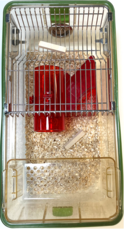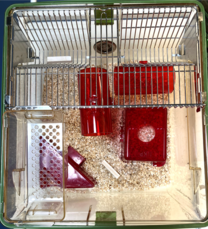Housing and breeding
The Animal Facility at the Department of Biomedicine offers housing and breeding of laboratory mice and rats. On this page you can find detailed descriptions of our housing and breeding methods as well as enrichment of the experimental animals.
Housing
All rodents are, as standard, housed in Individually Ventilated Cage systems (IVC) with ad libitum access to food and water from a central watering system. Mice are housed in GM500 or GR900 cages, while rats are housed in GR1800 cages. Cage area per animal meets the requirements of the EU and national legislation. The Animal Facility at Department of Biomedicine have also set their own guidelines, which in most cases allocate more space per animal than the official requirements. This is done both from a welfare perspective, but also from a practical perspective, which in most cases results in all cages being changed once a week.
Number of animals per cage
Mice
| Mice < 10 weeks | Mice > 10 weeks | Mice, diabetic | Mice, breeding | |
| GM500 | 5 | 4 | <4 | 1:1 + offspring max. 3-4 weeks old. If more than 6 pups, move to GR900. |
| GR900 | 10 | 8 | <8 | 2:1 + offspring max. 3-4 weeks old |
| Single use cage | 4 | 3 ♂, 4 ♀ | - | - |
Rats
| Rats < 5 weeks | Rats > 5 weeks | Rats, diabetic | Rats, breeding | |
| GR1800 | 6-8 | 3 ♂, 4 ♀ | <3 | 1:1 + offspring max. 3-4 weeks old |
| Single use cage | 3 | - | - | - |
Housing environment
All cages are mechanically ventilated with Scanclime air handling units. Scanclimes deliver an average of 75 air changes per hour. In dry periods, typically during winter, they can humidify the air used to ventilate the cages. The temperature in the housing rooms is kept between 20-24º C and the relative humidity is 55% (±10%). We use a 12/12-hour light/dark cycle with lights on at 6:00 AM. Maximum caging density is described above and specified in the collapsible container 'Number of animals per cage'.
Food and water
Animals kept under standard housing receive food and water ad libitum. We use maintenance and breeding diet for rodents from the manufacturer Altromin. The maintenance diet has product number #1328 and the breeding diet has product number #1318. We receive both diets in an nutrient enriched version because they are autoclaved before entering The Animal Facility. For severely immune deficient animals we use the enriched diet with product number #1319 in an extrudate version.
Animals receive water from an automated watering system delivered by Avidity Science. The water is reverse osmosis (RO) with added chlorine. The level of free, active chlorine is between 0.8-2.0 ppm.
Enrichment
To reduce stress and encourage, as well as enable, species-specific behavior, all our mice and rats are offered environmental enrichment in terms of bedding, nesting material, hiding place (refuge) as well as manipulable materials or food items. The animals are always housed in social groups to the greatest extent possible.
Content in a standard cage consists of aspen wood chips bedding (x mm) from Tapvei, Sizzlenest nesting material from Datesand Group or paper shavings from x, a cardboard tube from x and a triangular cardboard house from x. If compatible with the breeding or experiments, animals may be offered peanuts (with or without shell), oatmeal or occasionally hazlenuts with shell as food enrichment items.
Cage Change Intervals
| Cage Type | Weeks |
| GM500: 1 mouse (♂/♀) | 4 |
| GM500: 2 or 3 mice (♂/♀) | 2 |
| GM500: 4 mouse (♂/♀) | 1 |
| GM500 (breeding 1:1), 2 adults + pups | 2 |
| GM900: 5 - 8 mice (♂/♀) | 2 |
| GM900 (breeding 2:1), 3 adults + pups | 2 |
Breeding
The animal caretakers can offer assistance with keeping and breeding as well as maintenance of rodent colonies. They can help with both routine and highly specialized services such as:
- Breeding, weaning and euthanasia
- Marking and identification
- Collection of biopsy samples for genotyping
- Care of rodent colonies and maintenance of transgenic lines, including advice on genetic drift and renewal and backcrossing of transgenic and GM strains
For more information on what The Animal Facility staff can help you with, please see Technical assistance.
Health monitoring
All colonies of mice and rats are regularly monitored according to official FELASA guidelines. See Health status for further information.

